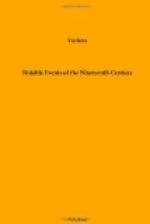The work of picture taking in the interior of bodies and through opaque materials was quickly taken up by philosophers in England, France and the United States. Almost everywhere the physical laboratories witnessed daily this form of experimentation. Swinton, of London; Robb, of Trinity College, Dublin; Morton, of New York; Wright, of Yale University, and in particular Thomas A. Edison, of Menlo Park, attacked the new problem with scientific zeal, and with startling results. It remained for Edison to discover that the new force acted in some respects in the manner of sound rather than in the manner of light. Thus, for example, he showed that the invisible rays not only pass through substances that are opaque to light and non-conductors of electricity, but that the invisible rays run around the edges and sides of plates, then proceeding on their way somewhat in the manner of sound. A sound made on one side of a metallic plate is heard on the other side partly by transmission through the plate, and partly by going around the edges, by atmospheric transmission. The new force rays act in this manner, and Edison is said to have procured pictures by means of the invisible agent while it was going around the corner of an opaque obstruction!
The pre-eminence of Thomas A. Edison as a scientific explorer and inventor depends upon a quality of mind which enables him more easily than others—more distinctly than any others—to see the touch of each new discovery with existing conditions, and the application of it to the problems of life. Edison catches the premonitory spark struck in the darkness by some other master’s hammer, and with that kindles a conflagration. Though not the discoverer of the Roentgen ray, he was able, as it would appear, to understand that discovery better even than the discoverer. He almost immediately applied the new increment of knowledge more successfully, we think, than any contemporary scientist. His experimentation led him directly to the discovery of the important fact that no photographic apparatus of any kind is needed to enable an observer to use the X-rays in the delineation or inspection of objects through opaque substances. He said within himself: “Why not pass the X-rays through the object to be inspected and then convert them into visibility, as if by fluorescence.”
This scientific question Edison almost immediately solved. Fluorescence is a property which some transparent bodies have of producing, either on their surface or within their substance, light different in color from that of its origin. This happens, for example, when green crystals of fluor spar afford blue reflections of light. Glass may be rendered fluorescent, as is seen in the Geisler and Crookes tubes. Edison conceived the project of using this phenomenon to get back the invisible rays into visibility.




